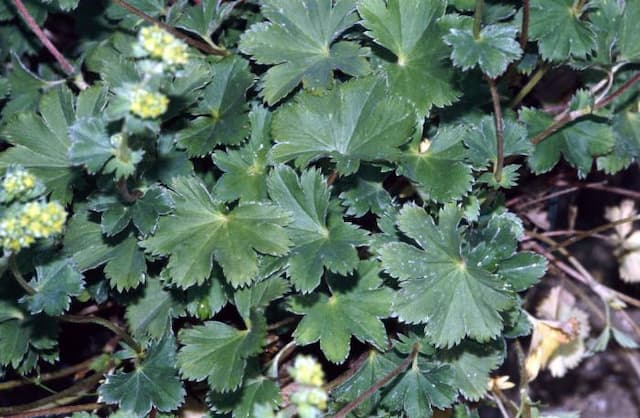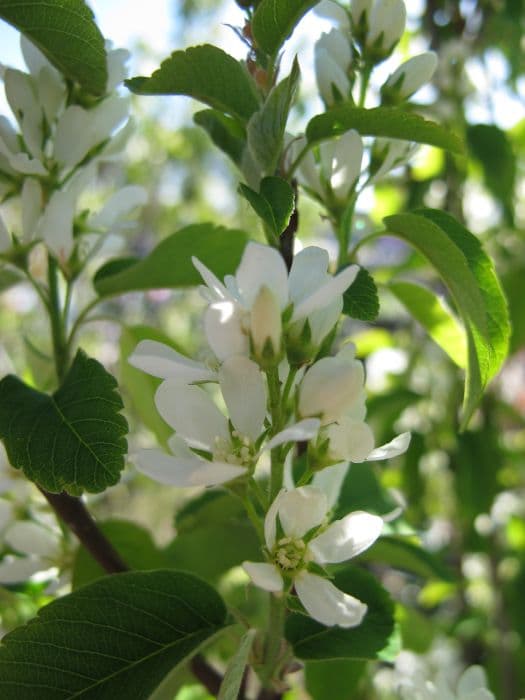Silver Cinquefoil Potentilla argentea

ABOUT
Commonly known as silver cinquefoil, this plant exhibits a bushy appearance with intricately branched stems that give it a somewhat sprawling look. The leaves of silver cinquefoil are one of its most distinctive features, being palmately divided with typically five leaflets. These leaflets possess a silvery quality due to the fine hairs that cover them, which can be particularly dense on the undersides, thus giving the foliage a grayish aspect. The flowers of the silver cinquefoil add a cheerful note to its appearance. They are small, with five bright yellow petals that radiate outwards from a central disc. These blossoms are arranged individually or in small clusters at the ends of the stems, and they boast a simple yet classic wildflower beauty. The base of the plant usually forms a woody caudex from which the herbaceous stems grow seasonally. Overall, the combination of its silver-colored foliage and yellow flowers makes the silver cinquefoil a visually striking plant across the seasons.
About this plant
 Names
NamesFamily
Rosaceae
Synonyms
Silver Cinquefoil, Silvery Cinquefoil, Hoary Cinquefoil, Five-finger Grass
Common names
Argentina anserina, Potentilla anserina var. anserinoides, Potentilla anserina var. yukonensis, Potentilla pacifica.
 Toxicity
ToxicityTo humans
Silverweed (Potentilla argentea) is not commonly known to be toxic to humans. There are no widely recognized symptoms of poisoning from ingesting Silverweed, and it is not typically considered a poisonous plant. That being said, eating any non-food plant matter can potentially cause mild stomach upset in some individuals due to non-toxic components or individual sensitivities. It's always best to err on the side of caution and avoid eating plants that are not specifically identified as edible food sources.
To pets
Silverweed (Potentilla argentea) is not commonly known to be toxic to pets. There is no well-documented evidence to suggest that it causes poisoning in animals such as dogs or cats. As with humans, ingestion of non-food plants can sometimes result in mild gastrointestinal upset in pets, but there are no specific toxic effects associated with Silverweed that would warrant concern for pet owners. However, to be on the safe side, preventing pets from eating ornamental or wild plants is generally advisable.
 Characteristics
CharacteristicsLife cycle
Perennials
Foliage type
Deciduous
Color of leaves
Green
Flower color
Yellow
Height
1 foot 4 inches (0.4 meters)
Spread
2 feet (0.6 meters)
Plant type
Shrub
Hardiness zones
3
Native area
Europe
Benefits
 General Benefits
General Benefits- Erosion Control: Potentilla argentea, commonly known as silver cinquefoil, has a robust root system which helps stabilize soil and prevent erosion.
- Drought Resistance: The plant is well-adapted to dry conditions, making it suitable for xeriscaping and water-wise gardens.
- Wildlife Habitat: It provides food and shelter for various insects and small animals, supporting biodiversity.
- Ornamental Value: With its silver-green foliage and yellow flowers, silver cinquefoil adds aesthetic appeal to gardens and landscapes.
- Low Maintenance: Once established, it requires minimal care, making it a convenient choice for gardeners seeking low-effort plants.
- Pollinator Support: The flowers of silver cinquefoil attract bees and other pollinators, benefiting the local ecosystem.
- Soil Improvement: Its presence can help improve soil quality over time through natural leaf and root decay, enriching the soil.
 Medical Properties
Medical Properties- Astringent: Traditionally used for its constricting and tightening effect on tissues.
- Anti-inflammatory: May reduce inflammation in various conditions.
- Antiseptic: Applied topically to aid in preventing infection in wounds.
- Gastrointestinal aid: Used to help treat issues such as diarrhea and gastrointestinal upset.
- Mouthwash ingredient: Because of its astringent properties, it is sometimes included in formulations for mouthwashes to treat sore throats and mouth ulcers.
 Air-purifying Qualities
Air-purifying QualitiesThis plant is not specifically known for air purifying qualities.
 Other Uses
Other Uses- Dye Production: The roots of the Silverweed can be used to produce a reddish-brown dye for wool and other fabrics.
- Insect Deterrent: The plant is known to repel certain insects, making it useful in gardens or when dried and utilized in natural insect repellent sachets.
- Plant Stabilization: Silverweed's dense growth can help stabilize soil and prevent erosion in vulnerable areas such as riverbanks.
- Livestock Feed: In some areas, Silverweed can be used as emergency fodder for livestock when other feed is scarce.
- Indicator Plant: Silverweed can indicate the presence of certain soil conditions, such as compacted soil, which can be valuable for ecological monitoring.
- Ornamental Use: Due to its attractive foliage and flowers, Silverweed is sometimes used in ornamental gardens for ground covering or borders.
- Traditional Crafts: Some cultures have used the strong, fibrous roots of Silverweed for weaving small items such as baskets or mats.
- Culinary Garnish: Although not widely used, the flowers of Silverweed can be used as an edible garnish in salads and cold dishes.
- Natural Fertilizer: The plant can be composted and used as a natural fertilizer due to its nutrient-rich composition.
- Education and Research: Silverweed serves as a subject for botanical study and education, highlighting topics such as plant adaptation and survival strategies.
Interesting Facts
 Feng Shui
Feng ShuiThe Silverweed is not used in Feng Shui practice.
 Zodiac Sign Compitability
Zodiac Sign CompitabilityThe Silverweed is not used in astrology practice.
 Plant Symbolism
Plant Symbolism- Resilience: Potentilla argentea, commonly known as silver cinquefoil, has the ability to thrive in difficult conditions, symbolizing resilience and the capacity to overcome challenging situations.
- Persistence: Its hardy nature represents perseverance and the determination to persist through adversity.
- Protection: Historically, some species in the Potentilla genus were believed to possess protective properties, hence silver cinquefoil may symbolize safeguarding against harm.
- Humility: The modest appearance of the silver cinquefoil can represent humility, suggesting a simple yet significant beauty.
 Water
WaterThe Silver Cinquefoil should be watered deeply but infrequently, allowing the soil to dry out between waterings to avoid overwatering and possible root rot. Typically, providing about 1 inch of water every week without rainfall is sufficient, ensuring the plant's root zone is moistened. Adjustments to watering may be needed during periods of extreme heat or drought when additional water might be necessary to keep the plant healthy. During the winter, watering should be reduced significantly, as the plant requires less moisture when it is dormant.
 Light
LightSilver Cinquefoil thrives in a location that receives full sun to partial shade. The ideal spot ensures that the plant gets at least 6 hours of direct sunlight daily, which promotes healthy growth and flowering. While it can tolerate some light shade, too much shade can lead to leggy growth and fewer flowers.
 Temperature
TemperatureSilver Cinquefoil is hardy and can withstand a range of temperatures; however, it performs best when the temperature remains between 50°F and 70°F. The plant can survive minimum temperatures down to around -30°F, making it suitable for cold climates, and it can tolerate heat as long as the conditions are not excessively hot and dry.
 Pruning
PruningPruning Silver Cinquefoil is essential to maintain its shape and promote healthy, vibrant growth. It should be pruned in late winter or early spring before new growth begins. Remove any dead or damaged branches, and thin out the plant to improve air circulation, which can help prevent disease. Pruning can also be done after the plant flowers to encourage a second bloom.
 Cleaning
CleaningAs needed
 Soil
SoilSilver cinquefoil thrives best in a well-draining sandy loam with a slightly acidic to neutral pH between 6.0 and 7.0. The ideal soil mix for silver cinquefoil should consist of garden soil, sand, and compost in a ratio of 1:1:1 to ensure adequate drainage, nutrients, and airflow around the roots.
 Repotting
RepottingSilver cinquefoil does not require frequent repotting and can typically be repotted every 2-3 years. This period allows the plant to grow sufficiently without becoming too root-bound.
 Humidity & Misting
Humidity & MistingSilver cinquefoil prefers outdoor conditions and is tolerant of a wide range of humidity levels; it does not have specific humidity requirements for growth.
 Suitable locations
Suitable locationsIndoor
Place in bright light, minimal water.
Outdoor
Full sun, well-drained soil, minimal care.
Hardiness zone
3-8 USDA
 Life cycle
Life cycleThe life cycle of Potentilla argentea, commonly known as Silver Cinquefoil, begins with germination, where seeds sprout in spring when conditions of light, temperature, and moisture are suitable. The seedlings grow into a rosette of leaves at the soil surface, developing a deep taproot. During its vegetative stage, Silver Cinquefoil forms a clump of foliage with distinctive silvery, hairy leaves. It reaches maturity and flowers in early to mid-summer, producing small yellow flowers that are pollinated by insects. After pollination, flowers develop into small achenes (dry fruits), which are dispersed by various means, including wind and animals. The plant is perennial and enters a period of dormancy during winter before resuming growth in the spring, continuing its cycle for multiple years.
 Propogation
PropogationPropogation time
Spring-summer
Propogation: The most popular method of propagating Silver Cinquefoil (Potentilla argentea) typically involves the use of seeds. Sowing seeds can be done directly in the place of cultivation in the spring as the frost passes, or seeds can be started indoors about 6-8 weeks before the last expected frost. To maximize germination, seeds should be surface-sown on a well-draining soil mix and lightly pressed into the soil but not covered, as they require light to germinate. Keep the soil moist but not waterlogged. Seedlings are usually ready to transplant when they've developed several true leaves, which should be around the 4- to 6-inch (10-15 cm) height, and should be carefully acclimatized to outdoor conditions before being planted out at their final location.









